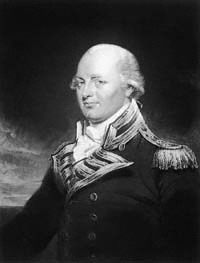Sir Charles Cotton, 5th Baronet
| Sir Charles Cotton | |
|---|---|

Sir Charles Cotton
by Henry Hoppner Meyer |
|
| Born | June 1753 |
| Died | 23 February 1812 Stoke House, Plymouth |
| Allegiance |
|
| Service/branch |
|
| Years of service | 1772 to 1812 |
| Rank | Royal Navy Admiral |
| Battles/wars |
American Revolutionary War • Boston Campaign • Long Island Campaign • Battle of Martinique • Battle of the Saintes French Revolutionary Wars • Glorious First of June • Cornwallis's action Napoleonic Wars • Corunna Campaign |
Sir Charles Cotton, 5th Baronet (June 1753 – 23 February 1812) was a senior Royal Navy officer of the French Revolutionary and Napoleonic Wars whose service continued until his death in command of the Channel Fleet from apoplexy in 1812. During his service, Cotton saw action off the Eastern Seaboard of the Thirteen Colonies and later at the Glorious First of June. Cotton's most influential service was in 1809 when he planned and executed the evacuation of thousands of British soldiers from Corunna after the disastrous collapse of the land campaign under Sir John Moore.
Cotton was the third child of Sir John Hynde Cotton, 4th Baronet, MP and Anne Parsons, daughter of Humphrey Parsons, Lord Mayor of London. Cotton was educated at Westminster School and Lincoln's Inn before joining the Royal Navy in 1772 as a midshipman on HMS Deal Castle. In 1775, during the American Revolutionary War, Cotton joined the frigate HMS Niger and participated in the Boston campaign in 1775 and Long Island campaign in 1776. In 1777, Cotton took command of the floating battery HMS Vigilant off the Chesapeake and supported the landing of British troops off the river. He was also promoted to lieutenant during the campaign.
...
Wikipedia
